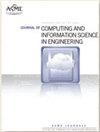Sensor Data Protection through Integration of Blockchain and Camouflaged Encryption in Cyber-physical Manufacturing Systems
IF 2.6
3区 工程技术
Q2 COMPUTER SCIENCE, INTERDISCIPLINARY APPLICATIONS
Journal of Computing and Information Science in Engineering
Pub Date : 2023-10-20
DOI:10.1115/1.4063859
引用次数: 0
Abstract
Abstract The advancement of sensing technology enables efficient data collection from manufacturing systems for monitoring and control. Furthermore, with the rapid development of the Internet of Things (IoT) and information technologies, more and more manufacturing systems become cyber-enabled, facilitating real-time data sharing and information exchange, which significantly improves the flexibility and efficiency of manufacturing systems. However, the cyber-enabled environment may pose the collected sensor data under high risks of cyber-physical attacks during the data and information sharing. Specifically, cyber-physical attacks could target the manufacturing process and/or the data transmission process to maliciously tamper the sensor data, resulting in false alarms or failures in anomaly detection in monitoring. In addition, the cyber-physical attacks may also enable illegal data access without authorization and cause the leakage of key product/process information. Therefore, it becomes critical to develop an effective approach to protect data from these attacks so that the cyber-physical security of the manufacturing systems could be assured in the cyber-enabled environment. To achieve this goal, this paper proposes an integrative blockchain-enabled data protection method by leveraging camouflaged asymmetry encryption. A real-world case study that protects cyber-physical security of collected sensor data in additive manufacturing is presented to demonstrate the effectiveness of the proposed method. The results demonstrate that malicious tampering could be detected in a relatively short time (less than 0.05ms) and the risk of unauthorized data access is significantly reduced as well.通过集成区块链和伪装加密在信息物理制造系统中的传感器数据保护
传感技术的进步使得从制造系统中有效地收集数据用于监测和控制成为可能。此外,随着物联网(IoT)和信息技术的快速发展,越来越多的制造系统实现了网络化,实现了实时数据共享和信息交换,极大地提高了制造系统的灵活性和效率。然而,在网络环境下,采集到的传感器数据在数据和信息共享过程中可能面临网络物理攻击的高风险。具体来说,网络物理攻击可以针对制造过程和/或数据传输过程恶意篡改传感器数据,导致假警报或监测异常检测失败。此外,网络物理攻击还可能导致未经授权的非法数据访问,并导致关键产品/工艺信息的泄露。因此,开发一种有效的方法来保护数据免受这些攻击变得至关重要,这样制造系统的网络物理安全才能在网络支持的环境中得到保证。为了实现这一目标,本文提出了一种利用伪装不对称加密的集成区块链数据保护方法。一个真实的案例研究,保护增材制造中收集的传感器数据的网络物理安全,以证明所提出的方法的有效性。结果表明,可以在相对较短的时间内(小于0.05ms)检测到恶意篡改,并且大大降低了未经授权访问数据的风险。
本文章由计算机程序翻译,如有差异,请以英文原文为准。
求助全文
约1分钟内获得全文
求助全文
来源期刊
CiteScore
6.30
自引率
12.90%
发文量
100
审稿时长
6 months
期刊介绍:
The ASME Journal of Computing and Information Science in Engineering (JCISE) publishes articles related to Algorithms, Computational Methods, Computing Infrastructure, Computer-Interpretable Representations, Human-Computer Interfaces, Information Science, and/or System Architectures that aim to improve some aspect of product and system lifecycle (e.g., design, manufacturing, operation, maintenance, disposal, recycling etc.). Applications considered in JCISE manuscripts should be relevant to the mechanical engineering discipline. Papers can be focused on fundamental research leading to new methods, or adaptation of existing methods for new applications.
Scope: Advanced Computing Infrastructure; Artificial Intelligence; Big Data and Analytics; Collaborative Design; Computer Aided Design; Computer Aided Engineering; Computer Aided Manufacturing; Computational Foundations for Additive Manufacturing; Computational Foundations for Engineering Optimization; Computational Geometry; Computational Metrology; Computational Synthesis; Conceptual Design; Cybermanufacturing; Cyber Physical Security for Factories; Cyber Physical System Design and Operation; Data-Driven Engineering Applications; Engineering Informatics; Geometric Reasoning; GPU Computing for Design and Manufacturing; Human Computer Interfaces/Interactions; Industrial Internet of Things; Knowledge Engineering; Information Management; Inverse Methods for Engineering Applications; Machine Learning for Engineering Applications; Manufacturing Planning; Manufacturing Automation; Model-based Systems Engineering; Multiphysics Modeling and Simulation; Multiscale Modeling and Simulation; Multidisciplinary Optimization; Physics-Based Simulations; Process Modeling for Engineering Applications; Qualification, Verification and Validation of Computational Models; Symbolic Computing for Engineering Applications; Tolerance Modeling; Topology and Shape Optimization; Virtual and Augmented Reality Environments; Virtual Prototyping

 求助内容:
求助内容: 应助结果提醒方式:
应助结果提醒方式:


